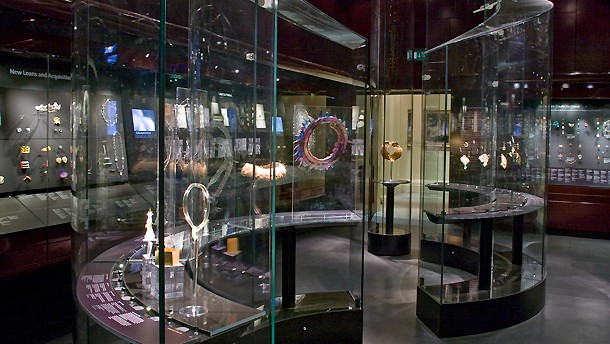A visit to the jewelry collection at London’s Victoria & Albert Museum should be on the bucket list of any antique and vintage jewelry lover. The 3,000+ piece collection is a veritable trip back in time, offering the opportunity to see jewelry history from 1500BC to today, and the designs and trends that influenced our favorite pieces from the Georgian, Victorian, and Art Deco periods.
The museum’s collection is a testament to both craftsmanship and care. Most pieces are in excellent condition and several were donated from what must have been spectacular personal collections. It’s easy to be entranced as you learn about the evolution of design and gemstone cutting, and the expansion of materials available to craftsmen through the ages – as shown by the pieces themselves.
Curators did not scrimp on the details: each case provides information on notable historical and cultural events that steered trends, such as why iron jewelry was created during the Napoleonic Wars, and brief biographies of influential craftsmen and designers. For those who crave item specifics, each case has a binder with a complete listing for each piece.
Etruscan gold rosette made in Tuscany c. 500-400 BC.
Gold earrings made by Castellani's student Carlo Giuliano c. 1865.
To first see original Etruscan gold granulated wire work c.300 BC, and Castellani’s 19th century Etruscan Revival cannatile jewelry later on, is a real treat. Other collection highlights include incredibly detailed ancient gold chains, the Canning Jewel (a merman brooch with a large natural pearl torso), Art Nouveau enamel designed by René Lalique, and floral diamond tiaras with moving parts (en tremblant) for extra sparkle.
The Canning Jewel, most likely of European origin c. 1800-1865, with enameled gold, natural pearls, table cut diamonds and Indian rubies.
Lalique enamel, opal and horn bodice ornament c. 1903
Western European diamond tiara c. 1835
Smaller exhibits are organized around different themes, bringing the jewelry’s symbolism and personal significance to life. “Cradle to the Grave” highlights materials and designs believed to be integral to different stages of life: from shell fertility amulets to protective figa pendants to jet and onyx mourning jewelry.
For those wanting to test their gemstone knowledge, a 154 piece collection donated to the museum in 1869 by Rev. Chauncy Hare Townshend displays a range of precious and semiprecious stones mounted in gorgeous rings. The swirling, colorful display of sapphires, tourmalines, garnets and more is a spectacular reminder that certain gemstones can surprise you in their range of naturally occurring colors.
The Townshend gemstone collection was supplemented by a donation from A. H. Church in 1913. Church also compiled the first catalog of the museum's collection.
It’s also worth it to watch the intermittent video demonstrations, showing how artisans craft items such as enamel jewelry and pocket watch casings. Sadly, museum staff strictly enforce a no photography policy, so while you can’t take any pictures of your favorite pieces, an afternoon learning about them in this temple to personal adornment is a truly wondrous experience.







